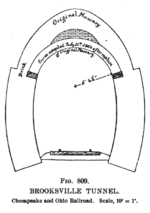Portal:Trains/Selected article/Week 19, 2013
The Brookville Tunnel (also Brooksville Tunnel) was a historic railroad tunnel engineered by Claudius Crozet during the construction of the Blue Ridge Railroad in the 1850s. The tunnel was part of a series of four tunnels used to cross the Blue Ridge Mountains of Virginia for the Virginia Central Railroad of the United States. The Brookville Tunnel was the second tunnel used to cross the mountains from the east (the easternmost being the Greenwood Tunnel), and was located approximately 1.5 miles (2.4 km) west of the village of Greenwood, Virginia. During the tunnel's construction, numerous cave-ins and landslides occurred because of the fragile and weak rock the tunnel passed through, and at one point, an outbreak of cholera forced work to stop. By October 1856 the tunnel was completed at a cost of $114,600, having been lined with a thick elliptical brick arch to hold back the earth. The Brookville Tunnel was used by the Virginia Central Railroad, and after 1868, the line's successor, the Chesapeake and Ohio Railroad. After the reorganization of the line in 1878 as the Chesapeake and Ohio Railway, the tunnel continued to be used until it was demolished and replaced by a cut during the construction of Interstate 64 in the 1960s and 1970s, at which point it was one of only two of Crozet's original four tunnels still in use.
Recently selected: - Axholme Joint Railway - Astoria Riverfront Trolley

